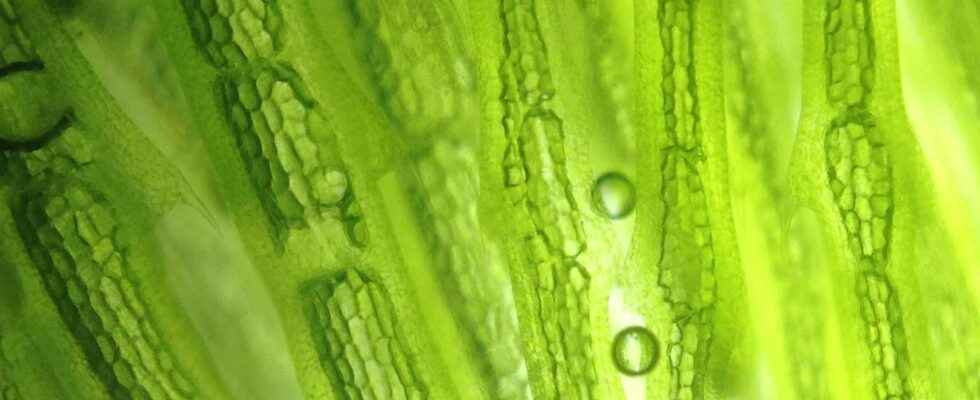You will also be interested
[EN VIDÉO] Will tomorrow’s biofuels be based on algae? European researchers are testing the performance, but also the profitability of a latest-generation biofuel that contains algae: they have produced enough to run a car and have embarked on the production of dedicated algae.…
From algae, there are all kinds. Green algae. Blue algae. From brown algae. And even red algae. Unicellular algae of microscopic size. Or multicellular algae that can reach impressive sizes. Up to several tens of meters long for ” sheets “ of the kelp giant – known to scientists as Macrocystis pyrifera. From ” sheets “, because precisely, what defines algae is that they have neither stems, roots, leaves, nor flowers. And if algae are better known for flourishing in aquatic environments, you should know that we also find them on the Earth closed. Although they generally remain invisible to our eyes.
“In desert environments — both in the polar regions and in the deserts hot — few plants grow. But, on the surface of the ground, one can observe like a crust formed mainly by algae. These algae, biologists have been studying them for a long time »explains Vincent Jassey, researcher at the CNRS Functional Ecology and Environment Laboratory.
His domain is the bogs. From wet area colonized by vegetation. And, by dint of observing algae in his samples, he ended up asking himself questions. “I wanted to know if we find algae everywhere and in what quantities. Also learn a little more about their primary productivity [comprenez, leur capacité à fixer du dioxyde de carbone (CO2), ndlr] and the role they play in the cycle of carbon», explains the researcher. Because, like plants, algae capture CO2 atmospheric. Present in significant quantities, they could therefore contribute to the storage of carbon in the soil.
Terrestrial algae all over the world
What emerges from the study published by Vincent Jassey is that, indeed, terrestrial algae are found in all regions of the world. In quantities which vary however according to the ecosystems. From desert environments to polar regions via tropical or temperate forests, wetlands or agricultural areas and grasslands. “From a few thousand to several million algal cells per gram of soil. » With an average that is still around five million algae per gram of soil. “Knowing that the algae are mainly found in the first two centimeters. »
This result, the researcher draws it from many data presented in the scientific literature. And the real surprise is that desert environments are not those in which terrestrial algae are most abundant. “They seem to prefer moist environments in temperate regions, environments that are also rich in vegetation », emphasizes Vincent Jassey. It is also in these environments that they seem to flourish the most. With a higher primary productivity than in other ecosystems. “We really had a biased picture of the distribution of algae in soils. Algae, for example, appreciate shady environments, those in which there is forest cover. They can then even land on the litter »tells us the researcher.
The role of algae in the carbon cycle
To determine the primary productivity of all these algae, it was necessary to supplement the information available in the scientific literature — very specific information, on very specific regions — with satellite data — data on temperature, precipitation, vegetation cover, soil humidity, etc. — and sift through theArtificial intelligence , machine learning. The output is a model that predicts the annual productivity of algae across the entire land surface. Including in areas for which researchers still lack field data. “Algae capture 3.6 gigatonnes (Gt) of carbon per year. It is substantial”, says Vincent Jassey. To get an idea, that’s 6% of what plants are able to fix each year — that’s 56 Gt. And that’s also 30% of the emissions of CO2 anthropogenic.
A new perception of soil microflora
“These results radically change our perception of soil microflora”, comments the researcher. Until then, biologists mainly saw in this microflora organisms — such as bacteriawhere the mushrooms — which decompose the litter and thus emit CO2. From now on, it will also have to be considered as a place of carbon assimilation. “There is a significant flow there that is not taken into account in the estimates of carbon footprint global models. » These models, in fact, are generally based on satellite measurements of the leaf chlorophyll. And therefore do not take into account carbon fixation by terrestrial algae.
Beyond the models that will therefore have to be revised, this work once again shows the importance of preserving soil microflora. They also call for going a little further. Because, what becomes of this CO2 fixed by algae? “Like algae in aquatic environments, terrestrial algae are eaten by organisms that then release CO2. But algae also produce a biomassdead which can be recalcitrant to decomposition and thus remain trapped in the soilexplains Vincent Jassey in conclusion. If this share of dead biomass turns out to be significant, the algae could really participate in the carbon sequestrationin the soils. »
Interested in what you just read?
